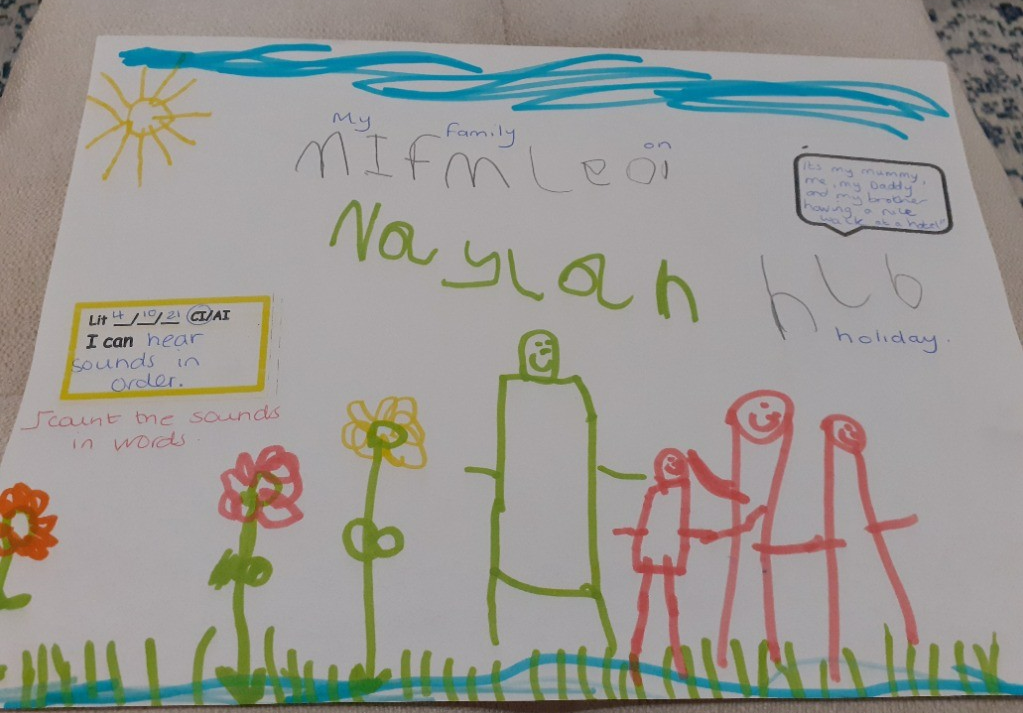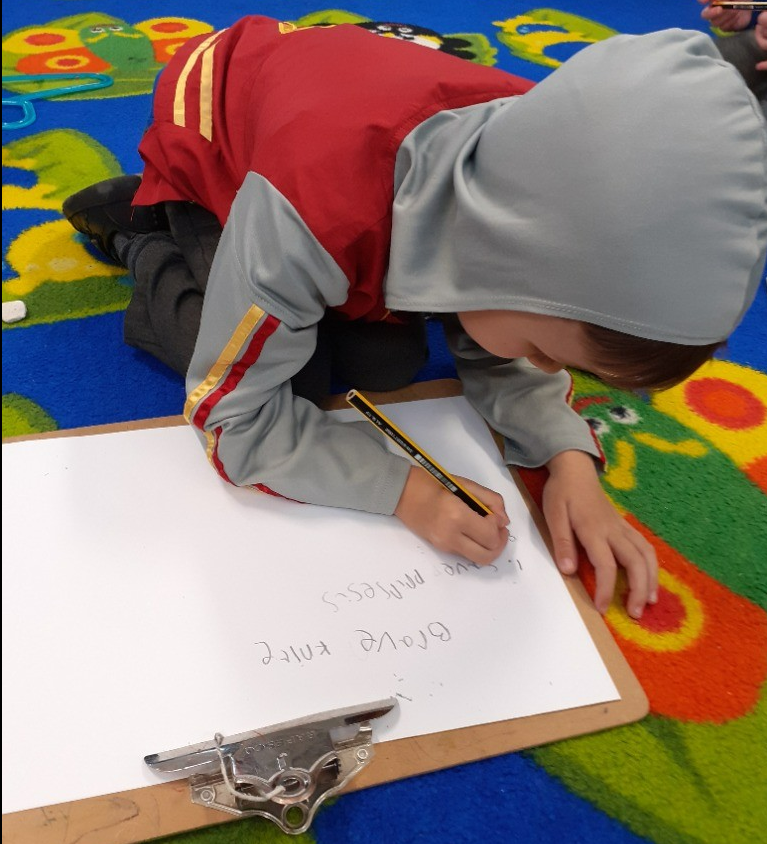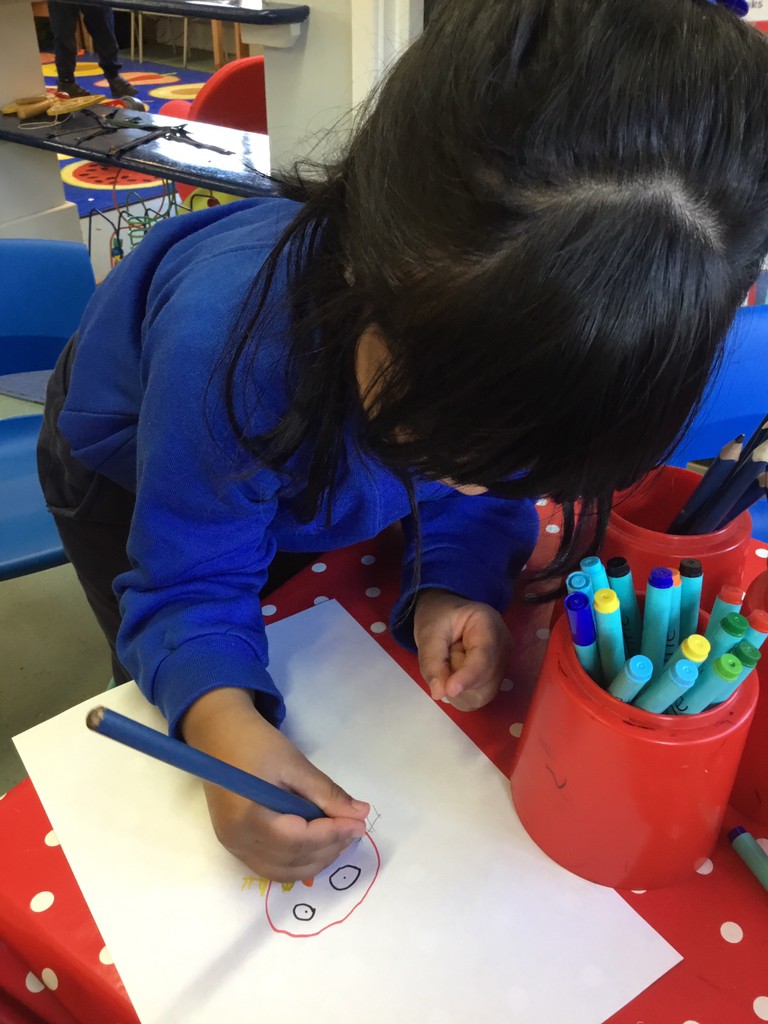- Home
- Learning and Curriculum
- Curriculum
- Early Years Foundation Stage (EYFS) Curriculum
- Learning and Development
- The Seven Areas of Learning and Development
- Literacy
Literacy
In this section...It is crucial for children to develop a life-long love of reading. Reading consists of two dimensions: language comprehension and word reading. Language comprehension (necessary for both reading and writing) starts from birth. It only develops when adults talk with children about the world around them and the books (stories and non-fiction) they read with them, and enjoy rhymes, poems and songs together. Skilled word reading, taught later, involves both the speedy working out of the pronunciation of unfamiliar printed words (decoding) and the speedy recognition of familiar printed words. Writing involves transcription (spelling and handwriting) and composition (articulating ideas and structuring them in speech, before writing).
Teaching and Learning for Reading
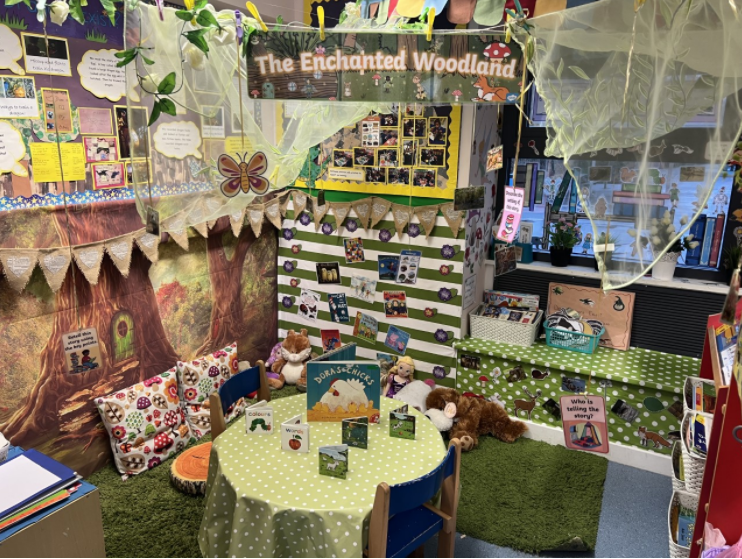
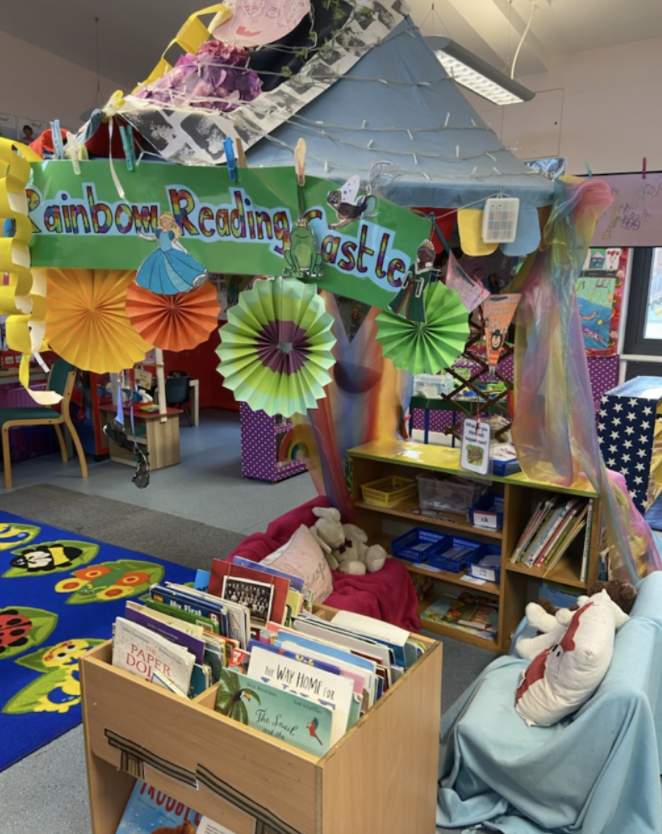
In addition to adult led learning for reading such as guided reading and phonics teaching, the enabling environment provides a rich reading resource. We ensure that our book areas are as inviting as possible. We have comfy chairs, cushions, puppets and props to make the experience engaging.
We also have books in numerous areas of the indoor classroom (and outdoors when appropriate) – craft books in the creative area, cookery books in the role play, construction and reference books in the small world area, for example.
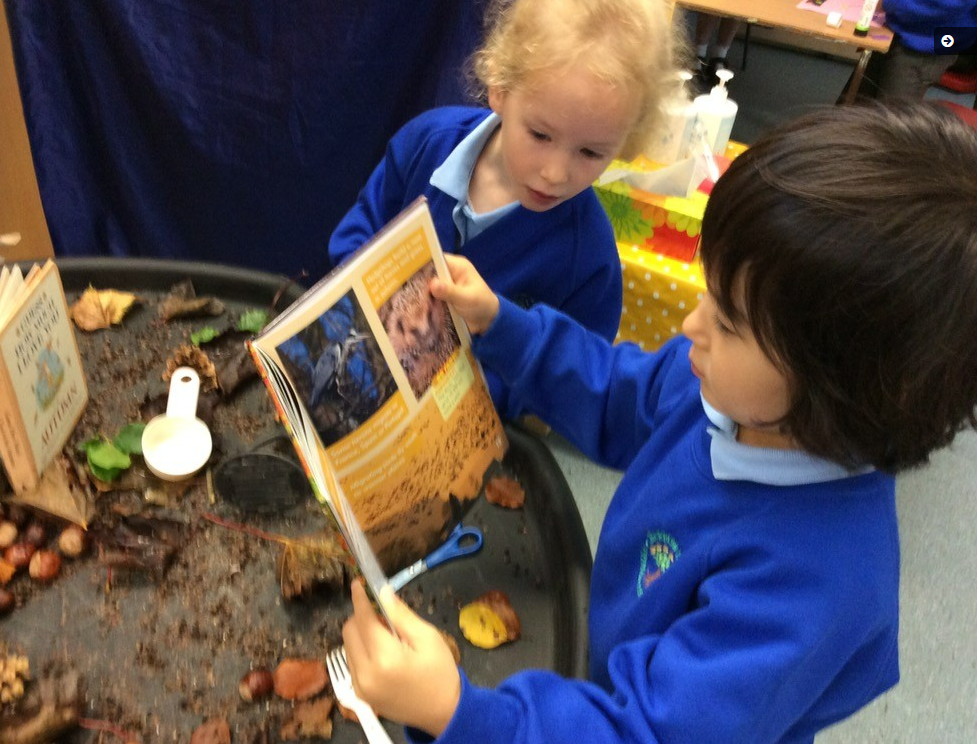
The children have their own book bag with their home-school reading book, which they can take out and read if they wish. Reading games and activities to consolidate and embed new learning are always available. Practitioners are the most valuable resource, encouraging children to read words in our print rich environment as well as reading stories to groups of children during the session. Story Time is an invaluable resource to support teaching and learning as children make progress towards the ELG for reading:
Children at the expected level of development will:
- Say a sound for each letter in the alphabet and at least 10 digraphs.
- Read words consistent with their phonic knowledge by sound-blending.
- Read aloud simple sentences and books that are consistent with their phonic knowledge, including some common exception words.” (ELG for reading)
Here's an example of high quality interactions that support literacy development, captured on our electronic platform, Tapestry.
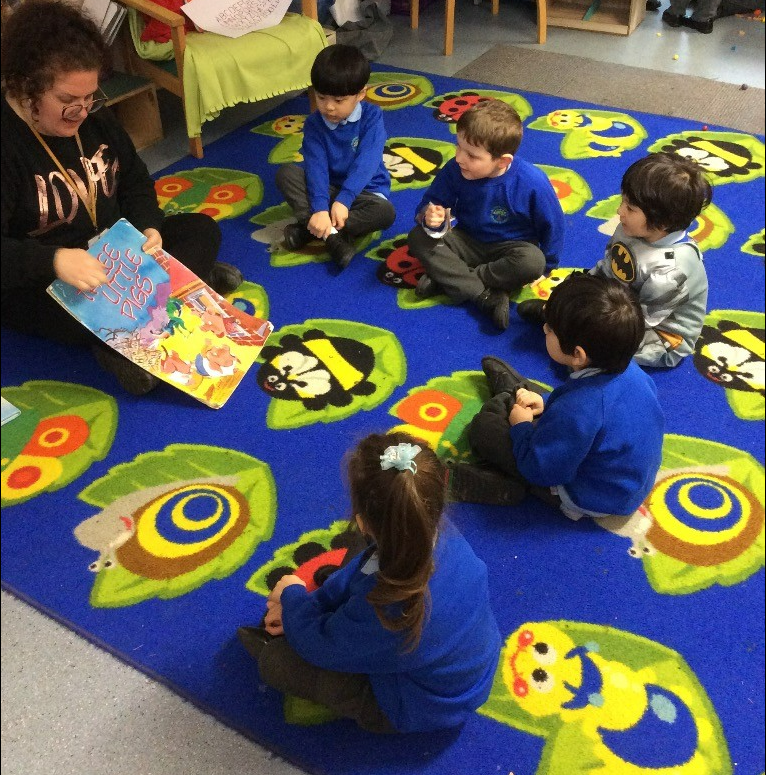
We love looking at books and sharing stories. Today Mrs Hutchison is going to read us the story called 'The three little pigs' (C) "I know that story I had that at my house before." Mrs Hutchison shows us the title on the front page and explains that this story is very old and that even when she was a little girl she used to read it. She tells us that lots of different people have written this story but today we are reading one by Brenda Parkes. Mrs Hutchison explains that she is the author and an author is someone who writes books. (F) "Like us, we authors. We write book about tall tall grass." We really enjoy listening to the story. (F) "I had story with once upon time before. It different story though. It do have goats in it." (A-M) "All the pigs boy pigs, they got boy clothes." (A) "My house is got bricks. Lots and lots of bricks." (C) "The wolf do huff and puff and blow and all the straw come down because straw not strong." (F) "Sticks do blow down in the wind. Like the storm." (T) "I got brick house." (C) "Why them pigs not live with them mummy." (A-M) "That wolf got sharp teeth. He not kind. He want eat the pigs." (T) "He huff puff blow." (C) "I think they should all build brick house. One house altogether. Then they be safe from the wolf." (F) "Why that wolf want eat them pigs. He need eat apple." (A-M) "That wolf go down chimney, he fall in water." (A) "He get burn because them pigs make fire." (F) "He gonna burn his tail." (C) "Yeah then he need go hospital."
Wow boys and girls what fantastic listening. I love how you commented on the story asking questions and sharing your thoughts. I'm also very impressed that you are beginning to adapt different parts to solve a problem differently.
Great Job 👏👍👏
Click here to view our Reception Reading Evening Presentation.
Story Time
Story time is a special time in Reception and Nursery where we come together to enjoy stories, poems and rhymes that helps us to remember our learning, to consolidate themed learning through information books and listen to stories for pleasure.
Phonics Teaching
At Barrow Hedges, we have created our own robust systematic synthetic phonics programme using Pearson’s Bug Club Phonics progression of sounds and decodable books. We prioritise the importance of teaching phonics by starting with Phase 1 in Nursery and consolidating this knowledge in Reception, before moving on to Phase 2.
Nursery Phonics
Children learn Phase 1 Phonics in Nursery:
- Environmental Sounds
- Instrumental Sounds
- Body Percussion
- Voice Sounds
- Rhythm and Rhyme
- Alliteration
- Oral Blending and Segmenting
In Nursery, children become aware of sounds in their environment through play and exploration. They go on listening walks to see what they can hear. Children will be able to identify sounds such as cars, emergency services, birds, wind and talking for example.
Children then move on to instrumental sounds. Children learn to identify a range of musical instruments such as a drum, bells and a shaker and will notice the difference between loud and quiet sounds. As this sound discrimination continues to develop, children will be able to use their own bodies to make sounds and we call this body percussion. We explore what noises/sounds we can make with our mouth, hands and feet, alongside singing lots of songs and action rhymes.
Then children move on to distinguishing between different voice sounds and will explore using deep, squeaky, whispering, happy voices for example. We use mirrors and look at our different faces for when we make different sounds. Later, Rhythm and Rhyme is developed. Rhythm is when we can hear a beat in a song, nursery rhyme or poem. Rhyme is when you can hear the same sound in different words. The children notice whether the words sound the same at the beginning or at the end. Children love to play ‘Silly Soup’ where different objects or pictures have to rhyme (sound the same either at the beginning or the end). For example, ‘dog’, ‘frog’ and ‘log’. This then leads children on to learning about Alliteration.
Alliteration is when more than one word begins with the same sound. For example, ‘Sammy slithers.’ Both words begin with the ‘s’ sound. Another example is, ‘big, brown bear.’ Children learn to play a range of alliteration games including ‘Bertha goes on the bus’ and ‘I-spy’ activities. This also develops children’s ability to distinguish between initial sounds by hearing them.
Finally, children learn about ‘Oral blending and segmenting’. This is where children learn to say a word, then stretch the word to hear and say all of the sounds within the word. For example, in the word ‘cat’, children will hear ‘c-a-t’ and know there are three sounds that make up the word 'cat'. Children will also practise and identify initial sounds in words through playing lots of different games with objects.
Reception Phonics
Children learn Phase 2 and Phase 3 Phonics in Reception. We follow the sound progression from ‘Bug Club’ Phonics books. Please see the order below:
Phase 2
Unit 1: s, a, t, p
Unit 2: i, n, m, d
Unit 3: g, o, c, k
Unit 4: ck, e, u, r
Unit 5: h, b, f, ff, l, ll, ss
Phase 3
Unit 6: j, v, w, x
Unit 7: y, z, zz, qu
Unit 8: ch, sh, soft th, hard th, ng
Unit 9: ai, ee, igh, oa, long oo, short oo
Unit 10: ar, or, ur, ow, oi
Unit 11: ear, air, ure, er
We use a multisensory approach to enable our children to know more and remember more by bringing the learning to life through our use of songs, stories, videos and physical props to enhance our teaching. Children in Reception have an awareness of technical vocabulary such as phoneme, grapheme, digraph (two letters together which makes one sound), trigraphs (three letters together which makes one sound), phoneme buttons and phoneme lines and use this knowledge in their daily phonics lessons. We support our children to segment and blend words in order to decode captions and sentences. Children track the text by using their ‘pointy finger’ which enables them to know where they are when they are reading. Children are encouraged to re-read their sentences back once the words have been decoded, in order to build fluency and support children’s automatic sight reading, as they rely on their segmenting and blending skills less. Children develop their comprehension skills through using picture clues and their understanding of the text to answer questions. Children are encouraged to talk about what is happening in the story at different points, to explain how they how a character is feeling and what they think will happen next for example. Children make fantastic progress in Phonics in Reception and by the end of the year, the vast majority of children are able to read and understand simple sentences containing at least ten digraphs.
Here's an example of phonics teaching in Reception:
Teaching and Learning for Writing
In addition to adult led learning sessions for writing and phonics, the enabling environment supports writing development. Young children combine their different types of mark-making – they make a card and write a message; they draw a picture and write a story; they create a robot and add labelled controls. Therefore, we have created a resource centre where the children can come and select from a wide range of mark-making tools, resources and writing equipment. We also provide mark-making equipment in each area of the indoor classroom. Outside provides the opportunity for bigger mark making. For example, children can make marks in the shaving foam or on the floor with a big paintbrush. They can keep score of a game on the large chalkboards.
We review our provision in terms of levels of involvement. If an area or a resource is not engaging children in purposeful play, then we remove it or change it. Observing children’s play provides further opportunities for writing. Practitioners will skilfully support the children to record their play by writing for a purpose. Every child is much more engaged in learning to write when they are in control of their learning. For example, drawing and labelling a plan for making a bird table in the woodwork area gives an exciting purpose and real-life context for writing. Practitioners are on hand to support this process helping the children to say their word or sentence aloud, to count the words in the sentence and to count the sounds in words for example.
Teachers monitor progress in writing carefully. They plan follow up work from identified next steps from children’s independent writing. The use of SMART targets supports the children to make good progress towards the ELG (Early Learning Goal) by the end of Reception:
Children at the expected level of development will:
- Write recognisable letters, most of which are correctly formed.
- Spell words by identifying sounds in them and representing the sounds with a letter or letters.
- Write simple phrases and sentences that can be read by others. (ELG for writing)
Click here to view our Reception Writing Evening Presentation.
